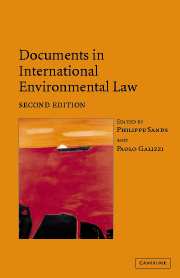Book contents
- Frontmatter
- Contents
- Preface
- PART I General instruments
- PART II Atmosphere
- PART III Oceans: global
- PART IIIB Oceans: regional
- PART IV Freshwater resources
- PART V Biodiversity
- PART VIA Hazardous substances and activities: nuclear
- PART VIB Hazardous substances and activities: pesticides
- PART VIC Hazardous substances and activities: waste
- 28 Convention on the Control of Transboundary Movements of Hazardous Wastes and Their Disposal, 22 March 1989
- 28A Decision III/1 of the Conference of the Parties (Amendment to the Basel Convention), 22 September 1995 (the ‘Basel Ban’)
- 28B Protocol on Liability and Compensation for Damage Resulting from Transboundary Movements of Hazardous Wastes and Their Disposal, 10 December 1999
- 29 Convention on the Ban of the Import into Africa and the Control of Transboundary Movement and Management of Hazardous Wastes within Africa, 29 January 1991
- 30 Code of Practice on the International Transboundary Movement of Radioactive Waste, 21 September 1990
- PART VII Human rights and the environment
- PART VIII War and the environment
- PART IX Trade and the environment
- PART X Environmental impact assessment and access to information
- PART XI Liability for environmental damage and breaches of environmental obligations
- PART XII The Antarctic
30 - Code of Practice on the International Transboundary Movement of Radioactive Waste, 21 September 1990
Published online by Cambridge University Press: 05 June 2012
- Frontmatter
- Contents
- Preface
- PART I General instruments
- PART II Atmosphere
- PART III Oceans: global
- PART IIIB Oceans: regional
- PART IV Freshwater resources
- PART V Biodiversity
- PART VIA Hazardous substances and activities: nuclear
- PART VIB Hazardous substances and activities: pesticides
- PART VIC Hazardous substances and activities: waste
- 28 Convention on the Control of Transboundary Movements of Hazardous Wastes and Their Disposal, 22 March 1989
- 28A Decision III/1 of the Conference of the Parties (Amendment to the Basel Convention), 22 September 1995 (the ‘Basel Ban’)
- 28B Protocol on Liability and Compensation for Damage Resulting from Transboundary Movements of Hazardous Wastes and Their Disposal, 10 December 1999
- 29 Convention on the Ban of the Import into Africa and the Control of Transboundary Movement and Management of Hazardous Wastes within Africa, 29 January 1991
- 30 Code of Practice on the International Transboundary Movement of Radioactive Waste, 21 September 1990
- PART VII Human rights and the environment
- PART VIII War and the environment
- PART IX Trade and the environment
- PART X Environmental impact assessment and access to information
- PART XI Liability for environmental damage and breaches of environmental obligations
- PART XII The Antarctic
Summary
Editorial note
The IAEA Code of Practice on the International Transboundary Movement of Radioactive Waste arose in part out of public reaction to unauthorised transboundary movement of radioactive waste to developing countries and concerns over how such wastes were managed and disposed of. The basic principles of the Code are that each State should minimise the amount of radioactive waste it produces (paragraph 2) and that any radioactive waste under its jurisdiction or control should be ‘safely managed and disposed of’ so as to protect human health and the environment (paragraph 1).
Against this background, the Code affirms the sovereign right of every State to prohibit the movement of radioactive waste on its territory (paragraph 3). If a Statedoes choose to involve itself in the transboundary movement of suchwaste, it should ensure that this takes place according to ‘international safety standard’ (paragraph 4) and, subject to the relevant rules of international law, after the sending, receiving and transit States have all been notified of such movement and given their consent (paragraph 5). States should establish an authority to regulate the transboundary movement of radioactive waste (paragraph 6) and should not permit the receipt of such waste unless it can manage and dispose of it in accordance with ‘international safety standards’ (paragraph 7). A corresponding duty is placed on the sending State who should be satisfied, prior to shipment and on the basis of the receiving State's consent, that the receiving State can manage and dispose of the waste according to ‘international safety standards’ (paragraph 7).
- Type
- Chapter
- Information
- Documents in International Environmental Law , pp. 968 - 972Publisher: Cambridge University PressPrint publication year: 2004



